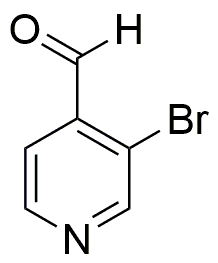3-Bromopyridine-4-carboxaldehyde is widely utilized in research focused on:
- Synthesis of Pharmaceuticals: This compound serves as an important intermediate in the synthesis of various pharmaceutical agents, particularly those targeting neurological disorders.
- Development of Agrochemicals: It is used in the formulation of agrochemicals, enhancing the efficacy of pesticides and herbicides through its unique chemical properties.
- Material Science: The compound is employed in the development of advanced materials, including polymers and coatings, due to its ability to modify surface properties.
- Organic Synthesis: As a versatile building block, it plays a critical role in organic synthesis, allowing researchers to create complex molecular structures efficiently.
- Fluorescent Probes: It is utilized in the creation of fluorescent probes for biological imaging, providing valuable insights into cellular processes and disease mechanisms.
Informations générales
Propriétés
Sécurité et réglementation
Applications
3-Bromopyridine-4-carboxaldehyde is widely utilized in research focused on:
- Synthesis of Pharmaceuticals: This compound serves as an important intermediate in the synthesis of various pharmaceutical agents, particularly those targeting neurological disorders.
- Development of Agrochemicals: It is used in the formulation of agrochemicals, enhancing the efficacy of pesticides and herbicides through its unique chemical properties.
- Material Science: The compound is employed in the development of advanced materials, including polymers and coatings, due to its ability to modify surface properties.
- Organic Synthesis: As a versatile building block, it plays a critical role in organic synthesis, allowing researchers to create complex molecular structures efficiently.
- Fluorescent Probes: It is utilized in the creation of fluorescent probes for biological imaging, providing valuable insights into cellular processes and disease mechanisms.
Documents
Fiches de données de sécurité (FDS)
La FDS fournit des informations de sécurité complètes sur la manipulation, le stockage et l’élimination du produit.
Spécifications du produit (PS)
Le PS fournit une description complète des propriétés du produit, notamment sa composition chimique, son état physique, sa pureté et les exigences de stockage. Il détaille également les plages de qualité acceptables et les applications prévues du produit.
Certificats d'analyse (COA)
Recherchez des certificats d'analyse (COA) en saisissant le numéro de lot du produit. Les numéros de lot et de lot se trouvent sur l'étiquette d'un produit, après les mots « Lot » ou « Lot de fabrication ».
Numéro de catalogue
Numéro de lot/série
Certificats d'origine (COO)
Ce certificat d'exploitation confirme le pays dans lequel le produit a été fabriqué, et détaille également les matériaux et composants utilisés et s'il est issu de sources naturelles, synthétiques ou autres sources spécifiques. Ce certificat peut être requis pour les douanes, le commerce et la conformité réglementaire.
Numéro de catalogue
Numéro de lot/série
Fiches de données de sécurité (FDS)
La FDS fournit des informations de sécurité complètes sur la manipulation, le stockage et l’élimination du produit.
DownloadSpécifications du produit (PS)
Le PS fournit une description complète des propriétés du produit, notamment sa composition chimique, son état physique, sa pureté et les exigences de stockage. Il détaille également les plages de qualité acceptables et les applications prévues du produit.
DownloadCertificats d'analyse (COA)
Recherchez des certificats d'analyse (COA) en saisissant le numéro de lot du produit. Les numéros de lot et de lot se trouvent sur l'étiquette d'un produit, après les mots « Lot » ou « Lot de fabrication ».
Numéro de catalogue
Numéro de lot/série
Certificats d'origine (COO)
Ce certificat d'exploitation confirme le pays dans lequel le produit a été fabriqué, et détaille également les matériaux et composants utilisés et s'il est issu de sources naturelles, synthétiques ou autres sources spécifiques. Ce certificat peut être requis pour les douanes, le commerce et la conformité réglementaire.


